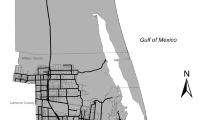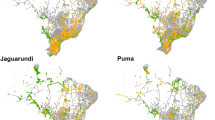Abstract
The conservation of wildlife populations living adjacent to roads is gaining international recognition as a worldwide concern. Populations living in road-impacted environments are influenced by spatial parameters including the amount and arrangement of suitable habitat. Similarly, heterogeneity in threatening processes can act at a variety of spatial scales and be crucial in affecting population persistence. Common wombats (Vombatus ursinus) are considered both widespread and abundant throughout their eastern Australian continental distribution. They nevertheless face many threats, primarily human induced. As well as impacts from disease and predation by introduced species, high roadside fatality rates on many rural roads are frequently reported. We parameterized a model for common wombat population viability analysis within a 750-km2 area of the northwestern corner of Kosciuszko National Park in New South Wales, Australia, and tested its sensitivity to changes in the values of basic parameters. We then assessed the relative efficiency of various mitigation measures by examining the combined impact from roads, disease and predation on wombat subpopulation persistence in the area. We constructed a stage-structured and spatially explicit model incorporating estimates of survival and fecundity parameters for each of the identified subpopulations using RAMAS GIS. Estimates of current threatening processes suggest mitigating road-kill is the most effective management solution. Results highlight the importance of recognizing the interplay between various threats and how their combination has the capacity to drive local depletion events.




Similar content being viewed by others
References
Akçakaya HR (2000) Viability analyses with habitat-based metapopulation models. Popul Ecol 42:45–53
Akçakaya HR, Atwood JL (1997) A habitat-based metapopulation model of the California gnatcatcher. Conserv Biol 11:422–434
Akçakaya HR, Raphael MG (1998) Assessing human impact despite uncertainty: viability of the northern spotted owl metapopulation in the northwestern USA. Biodivers Conserv 7:875–894
Akçakaya HR, Radeloff VC, Mlandenoff DJ, He HS (2004) Integrating landscape and metapopulation modeling approaches: viability of the sharp-tailed grouse in a dynamic landscape. Conserv Biol 18:526–537
Bank MS, Crocker JB, Davis S, Brotherton DK, Cook R, Behler J, Connery B (2006) Population decline of northern dusky salamanders at Acadia National Park, Maine, USA. Biol Conserv 130:230–238
Banks SC, Skerratt LF, Taylor AC (2002a) Female dispersal and relatedness structure in common wombats (Vombatus ursinus). J Zool 256:389–399
Banks SC, Piggott MP, Hansen BD, Robinson NA, Taylor AC (2002b) Wombat coprogenetics: enumerating a common wombat population by microsatellite analysis of faecal DNA. Aust J Zool 50:193–204
Bissonette JA, Adair W (2008) Restoring habitat permeability to roaded landscapes with isometrically-scaled wildlife crossings. Biol Conserv 141:482–488
Bond AR, Jones DN (2008) Temporal trends in use of fauna-friendly underpasses and overpasses. Wildl Res 35:103–112
Borchard P, Collins D (2001) Environmental management of the common wombat Vombatus ursinus: a case study in the Shoalhaven Region, southeastern New South Wales, Australia. Int J Ecol Environ Sci 27:185–190
Borchard P, McIlroy J, McArthur C (2008) Links between riparian characteristics and the abundance of common wombat (Vombatus ursinus) burrows in an agricultural landscape. Wildl Res 35:760–767
Brewer CA, Pickle L (2002) Evaluation of methods for classifying epidemiological data on choropleth maps in series. Ann Assoc Am Geogr 92:662–681
Brook BW, O’Grady JJ, Chapman AP, Burgman MA, Akcakaya HR, Frankham R (2000) Predicative accuracy of population viability analysis in conservation biology. Nature 404:385–387
Buchan A, Goldney DC (1998) The common wombat Vombatus ursinus in a fragmented landscape. In: Wells RT, Pridmore PA (eds) Wombats. Surrey Beatty & Sons, Chipping Norton, pp 251–261
Chisholm RA, Wintle BA (2007) Incorporating landscape stochasticity into population viability analysis. Ecol Appl 17:317–322
Corbett L (1995) The dingo in Australia and Asia. New South Wales University Press, Sydney
Coulson T, Mace GM, Hudson E, Possingham H (2001) The use and abuse of population viability analysis. Trends Ecol Evol 16:219–221
Delibes M, Ferreras P, Gaona P (2001) Attractive sinks, or how individual behavioural decisions determine source-sink dynamics. Ecol Lett 4:401–403
Downes SJ, Handasyde KA, Elgar MA (1997) The use of corridors by mammals in fragmented Australian eucalypt forests. Conserv Biol 11:718–726
Dunning JB, Stewart DJ, Danielson BJ, Noon BR, Root TL, Lamberson RH, Stevens EE (1995) Spatially explicit population-models—current forms and future uses. Ecol Appl 5:3–11
Efron B (1983) Estimating the error rate of the prediction rule: improvement on cross-validation. J Am Stat Assoc 78:316–331
Efron B, Tibshirani R (1997) Improvements on cross-validation: the.632 + bootstrap method. J Am Stat Assoc 92:548–560
English AW, Chapple RS (2002) A report on the management of feral animals by the New South Wales National Parks and Wildlife Service, Sydney, NSW
ESRI (2007) ArcGIS version 9.2. Redlands, California, USA
Evans MC (2008) Home range, burrow-use and activity patterns in common wombats (Vombatus ursinus). Wildl Res 35:455–462
Fahrig L (2007) Non-optimal animal movement in human-altered landscapes. Funct Ecol 21:1003–1015
Fahrig L, Rytwinski T (2009) Effects of roads on animal abundance: an empirical review and synthesis. Ecol Soc 14:21
Farrow S (1995) Extinction and market forces—2 case-studies. Ecol Econ 13:115–123
Forman RTT (2000) Estimate of the area affected ecologically by the road system in the United States. Conserv Biol 14:31–35
Forman RTT, Alexander LE (1998) Roads and their major ecological effects. Annu Rev Ecol Syst 29:207–231
Forman RTT, Sperling D, Bissonette JA, Clevenger AP, Cutshall CD, Dale VH, Fahrig L, France R, Goldman CR, Heanue K, Jones JA, Swanson FJ, Turrentine T, Winter TC (2003) Road Ecology: Science and Solutions. Island Press, Washington
Gaston KJ, Fuller RA (2007) Biodiversity and extinction: losing the common and the widespread. Prog Phys Geogr 31:213–225
Gaston KJ, Fuller RA (2008) Commonness, population depletion and conservation biology. Trends Ecol Evol 23:14–19
Glista DJ, DeVault TL, DeWoody JA (2009) A review of mitigation measures for reducing wildlife mortality on roadways. Landsc Urban Plan 91:1–7
Haines AM, Tewes ME, Laack LL, Horne JS, Young JH (2006) A habitat-based population viability analysis for ocelots (Leopardus pardalis) in the United States. Biol Conserv 132:424–436
Hartley M, English A (2005) Sarcoptes scabei var. wombati infection in the common wombat (Vombatus ursinus). Eur J Wildl Res 51:117–121
Hastie T, Tibshirani R, Friedman JH (2001) The elements of statistical learning: data mining, inference, and prediction. Springer, New York
Jaarsma CF, van Langevelde F, Botma H (2006) Flattened fauna and mitigation: traffic victims related to road, traffic, vehicle, and species characteristics. Trans Res D Trans E 11:264–276
Jaquiery J, Guelat J, Broquet T, Berset-Brandli L, Pellegrini E, Moresi R, Hirzel AH, Perrin N (2008) Habitat-quality effects on metapopulation dynamics in greater white-toothed shrews, Crocidura russula. Ecology 89:2777–2785
Jetz W, Rahbek C (2002) Geographic range size and determinants of avian species richness. Science 297:1548–1551
Johnson CJ, Boyce MS, Case RL, Cluff HD, Gau RJ, Gunn A, Mulders R (2005) Cumulative effects of human developments on arctic wildlife. Wildl Monogr 160:1–36
Kohmann SG, Schmidt GA, Garcelon DK (2005) A population viability analysis for the Island Fox on Santa Catalina Island, California. Ecol Model 183:77–94
Larson MA, Thompson FR, Millspaugh JJ, Dijak WD, Shifley SR (2004) Linking population viability, habitat suitability, and landscape simulation models for conservation planning. Ecol Model 180:103–118
Lennon JJ, Koleff P, Greenwood JJD, Gaston KJ (2004) Contribution of rarity and commonness to patterns of species richness. Ecol Lett 7:81–87
Lindenmayer DB, Incoll RD, Cunningham RB, Pope ML, Donnelly CF, MacGregor CI, Tribolet C, Triggs BE (1999) Comparison of hairtube types for the detection of mammals. Wildl Res 26:745–753
Lu H, Raupach MR, McVicar TR, Barrett DJ (2003) Decomposition of vegetation cover into woody and herbaceous components using AVHRR NDVI time series. Remote Sens Environ 86:1–18
Martin RW, Handasyde K, Skerrat L (1998) Current distribution of sarcoptic mange in wombats. Aust Vet J 76:411–414
Mata C, Hervas I, Herranz J, Suarez F, Malo JE (2008) Are motorway wildlife passages worth building? Vertebrate use of road-crossing structures on a Spanish motorway. J Environ Manage 88:407–415
May SA, Norton TW (1996) Influence of fragmentation and disturbance on the potential impact of feral predators on native fauna in Australian forest ecosystems. Wildl Res 23:387–400
McIlroy JC (1973) Aspects of the ecology of the common wombat Vombatus ursinus (Shaw, 1800). Ph.D. thesis, Australian National University, Canberra
McIlroy JC (1995) Common wombat. In: Strahan R (ed) The mammals of Australia. Reed Books, Chatswood, New South Wales, pp 204–205
Minor ES, Urban DL (2007) Graph theory as a proxy for spatially explicit population models in conservation planning. Ecol Appl 17:1771–1782
Ovaskainen O, Hanski I (2003) Extinction threshold in metapopulation models. Ann Zool Fenn 40:81–97
Ramp D, Caldwell J, Edwards KA, Warton D, Croft DB (2005) Modelling of wildlife fatality hotspots along the snowy mountain highway in New South Wales, Australia. Biol Conserv 126:474–490
R Development Core Team (2005) R: a language and environment for statistical computing. Vienna, Austria
Rishworth C, McIlroy JC, Tanton MT (1995) Factors affecting population densities of the common wombat, Vombatus ursinus, in plantations of Pinus radiata. For Ecol Manage 76:11–19
Rodewald PG, Santiago MJ, Rodewald AD (2005) Habitat use of breeding red-headed woodpeckers on golf courses in Ohio. Wildlife Soc Bull 33:448–453
Roedenbeck IA, Fahrig L, Findlay CS, Houlahan JE, Jaeger JAG, Klar N, Kramer-Schadt S, van der Grift EA (2007) The Rauischholzhausen agenda for road ecology. Ecol Soc 12:11
Roger E, Ramp D (2009) Incorporating habitat use in models of fauna fatalities on roads. Divers Distrib 15:222–231
Roger E, Laffan SW, Ramp D (2007) Habitat selection by the common wombat (Vombatus ursinus) in disturbed environments: implications for the conservation of a ‘common’ species. Biol Conserv 137:437–449
Rohlf DJ (1991) Six biological reasons why the Endangered Species Act doesn’t work -and what to do about it. Conserv Biol 5:273–282
Silverman BW (1986) Density estimation for statistics and data analysis. Chapman and Hall, New York
Skerratt LF (2001) Sarcoptic mange in the common wombat, Vombatus ursinus (Shaw, 1800). Ph.D. Thesis, University of Melbourne, Melbourne
Skerratt LF (2005) Sarcoptes scabiei: an important exotic pathogen of wombats. Microbiol Aust 26:79–81
Skerratt LF, Middleton D, Beveridge L (1999) Distribution of life cycle stages of Sarcoptes scabiei var wombati and effects of severe mange on common wombats in Victoria. J Wildl Dis 35:633–646
Skerratt LF, Skerratt JHL, Banks S, Martin R, Handasyde K (2004) Aspects of the ecology of common wombats (Vombatus ursinus) at high density on pastoral land in Victoria. Aust J Zool 52:303–330
Smith MD, Knapp AK (2003) Dominant species maintain ecosystem function with non-random species loss. Ecol Lett 6:509–517
Spellerberg IF (1998) Ecological effects of roads and traffic: a literature review. Global Ecol Biogeogr 7:317–333
Stevens VM, Baguette M (2008) Importance of habitat quality and landscape connectivity for the persistence of endangered natterjack toads. Conserv Biol 22:1194–1204
Triggs B (1988) The wombat: common wombats in Australia. Revised edition. New South Wales University Press, Kensington, New South Wales
Turner MG, Arthaud GJ, Engstrom RT, Hejl SJ, Liu JG, Loeb S, McKelvey K (1995) Usefulness of spatially explicit population-models in land management. Ecol Appl 5:12–16
Wintle BA, Elith J, Potts JM (2005) Fauna habitat modelling and mapping: a review and case study in the Lower Hunter Central Coast region of NSW. Aust Ecol 30:729–748
Acknowledgments
This work was made possible by the Scientific License (S11604) issued to David Croft by the DECC for work in Kosciuszko National Park. We thank Jo Caldwell (DECC), who initiated data collection. This project was funded by a University of New South Wales Faculty Research Grant awarded to SWL and DR.
Author information
Authors and Affiliations
Corresponding author
Rights and permissions
About this article
Cite this article
Roger, E., Laffan, S.W. & Ramp, D. Road impacts a tipping point for wildlife populations in threatened landscapes. Popul Ecol 53, 215–227 (2011). https://doi.org/10.1007/s10144-010-0209-6
Received:
Accepted:
Published:
Issue Date:
DOI: https://doi.org/10.1007/s10144-010-0209-6




